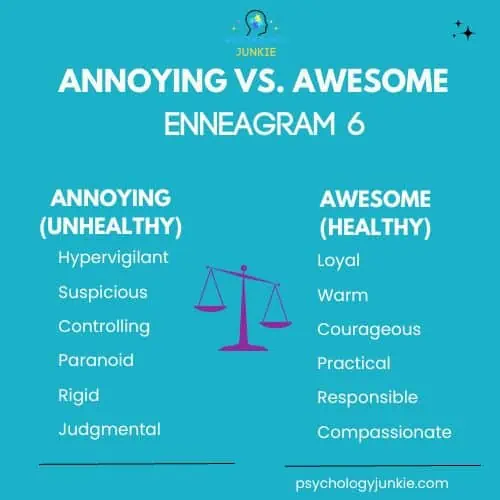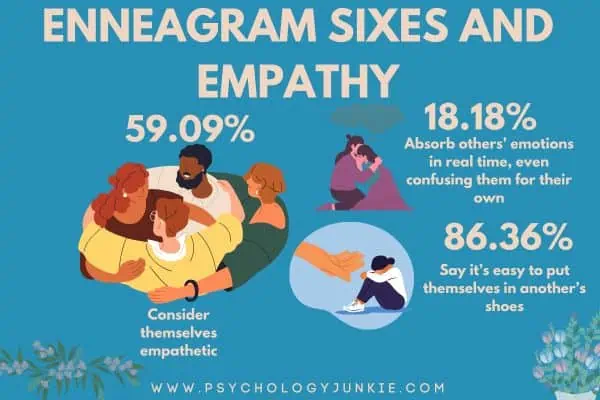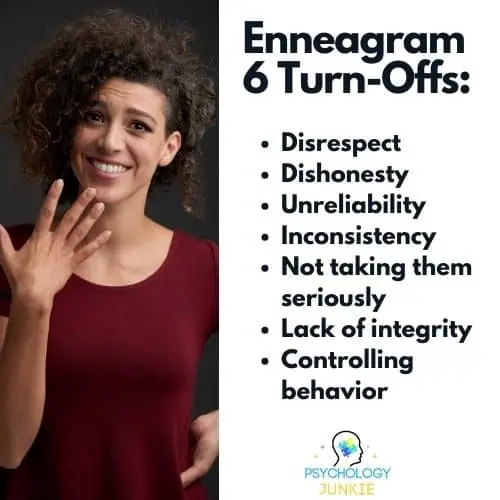The Enneagram 6 Relationship and Compatibility Guide
Enneagram 6 relationships. Which are the most compatible? Which are the most destructive? Today let’s dive into all the details. Sixes, also known as The Loyalists, are the ride-or-die friends of the Enneagram. They’re the ones who will back you up in a bar fight (after extensively analyzing the risks), text you to make sure you got home safe, and triple-check that the front door is locked before bed—just in case. Their defining trait? A deep, almost existential need for security and trust.
This need manifests in two main flavors:

- Phobic Sixes: The classic worriers. Cautious, approval-seeking, and always on the lookout for potential disasters. These Sixes tend to lean on authority figures, rules, or structures to feel safe.
- Counterphobic Sixes: The rebels. Instead of running from fear, they barrel straight into it. These Sixes can look like Eights—bold, confrontational, and allergic to showing vulnerability. But underneath the bravado? Still a Six, still scanning for threats, just hiding it better.
Not sure what your personality type is? Take our Enneagram questionnaire here!
Table of contents
- Why Relationships Matter So Much to Sixes
- What This Guide Covers
- Understanding the Enneagram Six in Love
- 1. The Core Needs and Desires of Sixes in Relationships
- 2. Strengths of Sixes in Relationships
- 3. Challenges of Sixes in Relationships
- The Three Instinctual Variants of Sixes in Relationships
- 1. Self-Preservation Sixes (“The Warmest Sixes”)
- 2. Sexual Sixes (“The Warrior Sixes”)
- 3. Social Sixes (“The Inner Committee Sixes”)
- Relationship Compatibility: The Six with Each Enneagram Type
- Six and One (“The Dutiful Duo”)
- Six and Two (“The Warm and Wary Pair”)
- Six and Three (“The Driven Team”)
- Six and Four (“The Emotional Allies”)
- Six and Five (“The Thinkers”)
- Six and Six (“The Trust Testers”)
- Six and Seven (“The Anchored Adventurers”)
- Six and Eight (“The Warrior Couple”)
- Six and Nine (“The Comforting Connection”)
- How Sixes Can Cultivate Healthy Relationships
- What Are Your Thoughts?
Why Relationships Matter So Much to Sixes

For Sixes, relationships aren’t just about love—they’re about survival. A good relationship means having a reliable partner to face the chaos of the world with. It’s the emotional equivalent of having a bunker stocked with non-perishable goods. Sixes want someone who:
✅ Has their back no matter what.
✅ Will reassure them that they’re not crazy (even when their brain is a full-blown conspiracy board).
✅ Stays consistent—because unpredictability is not their jam.
At their best, Sixes are fiercely loyal, funny, and dependable. At their worst? They’re overthinking everything, testing their partner’s loyalty (without meaning to), and stress-Googling things like “how likely is it that my significant other will suddenly disappear and change their name?”
What This Guide Covers
In this guide, we’re going to dive into:
- What Sixes need in relationships (besides a partner who can talk them down from worst-case-scenario spirals).
- The strengths they bring to the table.
- The challenges they need to be aware of (like maybe… just maybe… chilling out on the overanalyzing).
- Compatibility with other types and how to make relationships work without self-sabotaging.
Buckle up, Sixes. This one’s for you.
Understanding the Enneagram Six in Love
1. The Core Needs and Desires of Sixes in Relationships
At their heart, Sixes just want to feel safe—emotionally, physically, and existentially. Their ideal relationship is a mix of comfort, consistency, and a well-thought-out emergency preparedness plan. Here’s what they need from a partner:
- Security and Predictability: No flaky behavior, no surprises. Sixes want to know where they stand at all times. If you say you’ll text back, you better text back.
- Loyalty and Dependability: Sixes are loyal to a fault and expect the same in return. They don’t do casual, half-hearted commitment.
- Reassurance and Trust-Building: They don’t want to ask, “Are we okay?” for the fourth time today—but their brain might demand it. A little extra reassurance goes a long way.
- A Partner Who Is Strong but Not Controlling: They admire confidence but don’t want to be bulldozed. Mutual respect is key.
- Independence + Connection Balance: They crave closeness but also need space to overthink things in peace.
2. Strengths of Sixes in Relationships

Despite their anxieties, Sixes are solid gold partners. Here’s why:
✅ Loyal and Deeply Committed: When a Six is in, they are all in. No flighty behavior here.
✅ Protective and Supportive: They will defend you like their life depends on it—whether it’s against an actual threat or just a mean coworker.
✅ Witty, Playful, and Fun: When they’re comfortable, they’re hilarious. Sarcastic, quick-witted, and great at inside jokes.
✅ Hardworking and Responsible: Sixes take relationships seriously. They show up, do the work, and will not flake on you.
✅ Honest and Reliable: You’ll always know where you stand with a Six. They’re not about mind games.
3. Challenges of Sixes in Relationships

Of course, no type is perfect. Here’s where Sixes might struggle:
⚠️ Anxiety and Overthinking (“What if…?”)
Sixes are human “worst-case scenario” generators. Their brains are constantly spinning out possible disasters. What if they’re mad at me? What if they secretly hate me? What if this entire relationship has been an elaborate prank?
⚠️ Testing Loyalty (Without Realizing It)
Sixes might unconsciously “test” their partner to see if they’re truly reliable. They don’t mean to, but sometimes they pick fights or create hypothetical scenarios just to see how their partner will respond.
⚠️ Difficulty Trusting Their Own Instincts
Sixes second-guess everything. They might need outside validation before making decisions—even in their personal life.
⚠️ Hypervigilance and Fear of Worst-Case Scenarios
A happy relationship? Must be too good to be true. Sixes sometimes sabotage their own peace by scanning for problems that aren’t even there.
⚠️ Struggles with Indecisiveness
Choosing a place to eat? A small nightmare. Choosing a life partner? A 3-5 business year processing time. Sixes can get stuck in analysis paralysis, afraid of making the wrong choice.
The Three Instinctual Variants of Sixes in Relationships
Not all Sixes are built the same. While every Six is wired for loyalty and vigilance, their instinctual drive changes how they show up in relationships. Some seek security through connection, some through strength, and some through the backing of a trusted group. Let’s break it down.
1. Self-Preservation Sixes (“The Warmest Sixes”)
These Sixes are like emotional survivalists—but instead of stockpiling canned goods, they stockpile trust and likability. They believe that if people like them, they’ll be protected. And so, they become deeply attuned to how others perceive them, always scanning for signs of approval (or disapproval).
How This Shows Up in Relationships:
✅ They’re affectionate, warm, and eager to please.
✅ Even when upset, they try to keep things friendly—conflict feels unsafe.
✅ Their loyalty is next level. Once they commit, they’re all in.
✅ They analyze their partner’s mood constantly—if you sigh too loudly, they’re already wondering if they did something wrong.
Potential Struggles:
- They can be overly accommodating, afraid to rock the boat.
- Might rely too much on their partner for reassurance.
- Can develop a subtle but intense fear of abandonment, leading to over-apologizing or people-pleasing.
How to Thrive in a Relationship:
Self-Preservation Sixes do best with a partner who provides consistent reassurance but also encourages them to stand their ground. They need to hear, “You don’t have to keep proving yourself—I trust you.” Stability is everything to them, so a reliable, predictable relationship is their happy place.
2. Sexual Sixes (“The Warrior Sixes”)
If Self-Preservation Sixes seek safety through connection, Sexual Sixes seek safety through strength. They refuse to be the “scared one” in any situation—so instead, they lean into boldness, competitiveness, and intensity. This is where Sixes start looking a lot like Eights, with a tough exterior hiding a deeply anxious core.
How This Shows Up in Relationships:
✅ Passionate, intense, and full of energy.
✅ Can be fiercely protective of their partner.
✅ Push themselves to be strong—physically, intellectually, or emotionally.
✅ Often attracted to power, whether in their partner or in themselves.
Potential Struggles:
- Can be confrontational, sometimes picking fights just to test loyalty.
- Struggles to admit fear or vulnerability.
- May overcompensate by being too independent, making it hard for their partner to know how to support them.
How to Thrive in a Relationship:
Sexual Sixes need a partner who respects their strength but also makes room for their softer side. They don’t want to need reassurance, but deep down, they do. A partner who can say, “I see how strong you are, but you don’t have to be strong all the time,” will help them feel truly safe.
3. Social Sixes (“The Inner Committee Sixes”)
Social Sixes don’t just have anxiety—they have an entire internal board of directors debating every decision. Their “inner committee” is made up of voices from past authority figures (parents, teachers, society), and whenever they make a choice, they run it through multiple mental filters to make sure they’re doing “the right thing.”
How This Shows Up in Relationships:
✅ They’re deeply loyal to their partner and their chosen group (family, friends, community).
✅ Strong sense of responsibility—they want to be a good partner.
✅ Either follow rules to a T or break them, but only with backup.
✅ Highly aware of social dynamics—how their relationship “fits” into the bigger picture.
Potential Struggles:
- Can struggle with indecision, constantly questioning if they’re doing things “right.”
- Skeptical of outsiders—may need time to trust their partner’s friends or family.
- Can feel trapped between wanting stability and wanting to rebel.
How to Thrive in a Relationship:
Social Sixes need a partner who helps them tune out the noise and trust their own instincts. If they get caught up in worrying about what everyone else thinks, a supportive partner can remind them, “What do YOU want?” A relationship that offers both loyalty and a little bit of freedom is the sweet spot.
Relationship Compatibility: The Six with Each Enneagram Type
Sixes may not trust easily, but when they commit, they’re all in—loyal, protective, and willing to put in the work. That said, relationships with Sixes come with a few challenges: their overactive inner alarm system, their need for reassurance, and their habit of second-guessing everything (including their partner’s intentions).
How does that play out with different Enneagram types? Let’s break it down.
Six and One (“The Dutiful Duo”)
Sixes and Ones have a lot in common—they’re both hardworking, responsible, and take life very seriously (sometimes too seriously, let’s be honest). A Six in a relationship with a One might feel like they’ve found a built-in life manual—someone who always knows the “right” thing to do, while the Six is still lost in a spiral of What ifs and But have we considered the worst-case scenario?. Ones, on the other hand, admire the Six’s loyalty, wit, and deep sense of duty, but might wonder why their partner can’t just make a decision without crowd-sourcing opinions from 14 different people.
It can be a beautiful balance—or a high-stakes anxiety spiral where both partners end up stress-Googling how to fix a problem that doesn’t even exist yet.
A Story of a Six and a One in Action
Let’s say a Six and a One are planning a vacation. The Six wants to research every possible travel disaster—flight delays, pickpockets, hurricanes that haven’t even formed yet. The One is laser-focused on optimizing the trip—finding the best-rated restaurants, making sure the itinerary is logical, and internally judging anyone who dares to suggest a subpar hotel.
The Six panics: What if our hotel gets bed bugs? What if we get lost? What if I get food poisoning and ruin the trip for everyone?
The One sighs: Why do you make everything so complicated? Just book the place already!
The Six, feeling criticized, starts to second-guess the entire trip. Maybe they just shouldn’t go. The One, frustrated, wonders why their partner can’t just trust them to make a decision. A fight breaks out—not about the trip itself, but about whether the Six is too anxious or the One is too rigid. Sound familiar?
What Sixes Love About Ones:
- Ones provide structure, stability, and a moral compass, which is basically a Six’s dream scenario—knowing exactly where they stand.
- They admire the One’s hard work, integrity, and reliability. If a One says they’ll do something, they do it (a trait Sixes respect deeply).
- Ones help Sixes prioritize and make decisions instead of letting them rot in indecision purgatory (where the Six has overanalyzed so much, they now need an emergency nap).
- When a Six feels overwhelmed, a One steps in with practical solutions instead of feeding into their anxiety.
Potential Struggles:
- Ones have sky-high expectations, which can make a Six feel like they’re constantly falling short.
- Ones don’t understand why Sixes overthink everything instead of just taking action. Meanwhile, Sixes don’t understand how Ones aren’t overthinking everything.
- If a Six starts doubting the relationship (which, let’s be real, might happen at some point), a One may take offense instead of offering reassurance.
- Both are worriers. If they’re not careful, they can spiral into a stress-fueled apocalypse-planning session where neither is sure if life is even worth enjoying anymore.
How to Make It Work:
One of the biggest lessons for a Six-One couple? You’re on the same team. Sixes test loyalty, Ones test morality—but deep down, both just want security and stability.
- Ones need to soften their criticism. The Six already has an internal panel of judges dissecting their every move—they don’t need another one. A little reassurance goes a long way.
- Sixes need to trust their One partner more. Not every decision needs a congressional hearing and 12 contingency plans.
- Instead of amplifying each other’s anxiety, they should work together to find practical solutions. Stressing out in stereo is not the answer.
- Compromise is key. The Six can have their emergency backup plans, but the One doesn’t need to live in a constant state of exasperation over it.
At the end of the day, this pairing can ground each other—as long as they remember that perfection isn’t the goal; trust is.
Six and Two (“The Warm and Wary Pair”)
A Six and a Two walk into a relationship. The Two is all warmth, affection, and heartfelt devotion, practically radiating I love you and I will take care of you forever energy. The Six, meanwhile, is mentally compiling a list of reasons this could all go horribly wrong.
Twos thrive on connection; Sixes crave security but struggle to trust it. It’s a classic case of “Do you really love me?” versus “Of course I do, how could you even question that?”—and if they’re not careful, this dynamic can turn into a hamster wheel of reassurance requests and emotional exhaustion.
But when it works? This pairing is magic. The Two’s kindness and optimism help the Six relax, and the Six’s loyalty makes the Two feel truly valued and appreciated. Together, they can create an unshakable foundation of love, trust, and shared neuroses—as long as they learn to navigate their differences.
A Story of a Six and a Two in Action
Picture this: The Two is chatting with the barista at their favorite coffee shop, flashing their usual warm smile and making easy conversation. The Six, sitting nearby, is watching this unfold like it’s a true crime documentary.
The Six’s brain starts spiraling: Are they this nice to everyone? Are they flirting? They said “thank you” in a way that seemed extra enthusiastic—was that suspicious?
The Two, completely oblivious to the crisis unfolding next to them, turns back to the Six and says, “Wow, that barista was so sweet!”
The Six forces a smile but is already mentally drafting a list of probing questions they will absolutely be bringing up later.
What Sixes Love About Twos:
- Twos make Sixes feel safe, valued, and appreciated. Nothing soothes an anxious heart like steadfast love and care.
- They’re affectionate, warm, and full of encouragement. When a Six is spiraling, the Two swoops in like a comforting human blanket.
- Twos see the good in Sixes, even when Sixes don’t see it in themselves. They remind the Six, “Hey, you’re amazing, stop overanalyzing everything.”
- Twos bring lightness and joy into the relationship. Sixes can get stuck in doom-and-gloom mode, and Twos help them laugh, breathe, and enjoy the moment.
Potential Struggles:
- Twos are naturally friendly with everyone, which can trigger the Six’s trust issues. The Six starts questioning: Are they this nice to the mail carrier? The grocery store cashier? That random guy on the street? (Spoiler: Yes.)
- Sixes’ skepticism can hurt the Two, who just wants to be trusted. A Six’s questioning might come off as doubt, when it’s really just fear.
- Twos give freely but also expect appreciation. A Six lost in anxiety might forget to say “Thank you for always being there for me.”
How to Make It Work:
This relationship has incredible potential, but it requires trust, patience, and clear communication.
- Sixes need to let their guard down and believe in the Two’s sincerity. Not every nice gesture has ulterior motives. Sometimes, love is just love.
- Twos need to understand that a Six’s suspicion isn’t a lack of love—it’s a fear response. They’re not questioning you to hurt you; they’re questioning because they’re scared to lose you.
- Clear communication is everything. If a Six is feeling insecure, they should express it directly instead of going full detective mode.
- Twos should offer reassurance, but not take the Six’s doubts personally. “I love you and I’m not going anywhere” goes a long way.
At their best, this couple balances warmth and security beautifully. The Two teaches the Six to trust love, and the Six teaches the Two that loyalty, once earned, is unwavering. When they lean into their strengths instead of their fears, this is a relationship that feels like home.
Six and Three (“The Driven Team”)
If Sixes and Threes were a couple in an action movie, the Three would be the fearless go-getter, scaling walls and making things happen, while the Six would be the strategic planner, double-checking the safety harness and running risk assessments. Together, they have the potential to be a high-functioning power couple, crushing goals, tackling challenges, and—when they’re in sync—bringing out the best in each other.
But let’s be real: sometimes, they drive each other absolutely nuts.
Threes move fast, making split-second decisions and have busy, project-filled lives. Sixes? They need time to analyze, double-check, and possibly poll a focus group before making a move. This can leave the Six feeling overwhelmed and left behind, while the Three wonders why everything has to be a debate instead of a decisive action.
At their worst, the Six feels neglected and insecure, while the Three feels smothered and slowed down. But when they learn to appreciate each other’s strengths? They become an unstoppable team.
A Story of a Six and a Three in Action
Let’s look at the scenario of a Six and a Three planning a weekend getaway.
The Three: “Let’s book the trip, pack a bag, and just go!”
The Six: “Wait, but have we compared prices? What if we get a bad Airbnb? What if the car breaks down in the middle of nowhere and we have no phone service and we’re never seen again?”
The Three, already halfway through booking: “Babe, it’s going to be fine. Worst case, we figure it out when we get there.”
The Six, horrified: “That is NOT a plan.”
This sums up a lot of their struggles: The Three lives for the thrill of forward motion, while the Six wants a well-researched roadmap with backup plans A, B, and C.
What Sixes Love About Threes:
- Threes bring energy, confidence, and drive. Being with a Three makes a Six feel like they’re part of a winning team.
- Their optimism and problem-solving skills help counterbalance a Six’s natural tendency toward worst-case scenario thinking.
- Threes push Sixes to take action instead of letting fear keep them stuck in decision paralysis.
- They’re both hardworking and practical, making them great partners in ambition—if they align on their goals.
Potential Struggles:
- Threes move fast, while Sixes hesitate. The Three sees an opportunity and jumps. The Six sees an opportunity and analyzes it from every possible angle before deciding maybe they should jump. This can frustrate both partners.
- Sixes crave emotional security, while Threes prioritize achievement. A Six needs to hear “I love you, I’m committed, and I’m not going anywhere.” A Three might assume that’s obvious—which doesn’t exactly soothe a Six’s overactive brain.
- Threes are image-conscious, while Sixes value authenticity. If a Three gets too focused on success and appearances, a Six might start questioning their sincerity (Are you just saying what I want to hear?).
- Sixes can misinterpret a Three’s ambition as emotional distance. Threes can get caught up in their work or personal goals, leaving the Six feeling neglected or unimportant.
How to Make It Work:
This relationship thrives when both partners lean into each other’s strengths instead of resenting their differences.
- Threes need to pause and reassure their Six partner more often. Even if the Three personally doesn’t need constant validation, the Six does. A simple “I appreciate you” goes a long way.
- Sixes need to trust their Three’s commitment instead of testing it. Just because a Three is focused on success doesn’t mean they’re not invested in the relationship.
- Work-life balance is key. If they’re only functioning as a business partnership instead of an emotional connection, resentment will creep in.
- Conflict resolution should be direct and solutions-focused. Threes hate dwelling on problems, and Sixes hate uncertainty—so the best approach is clear, honest, and efficient communication.
At its best, this relationship is a powerhouse combo of ambition and loyalty—the Three inspires the Six to be bold, and the Six keeps the Three grounded. They just have to make sure they’re running toward the finish line together, instead of constantly pulling each other in opposite directions.
Six and Four (“The Emotional Allies”)
A Six and a Four walk into a relationship, and immediately, it feels deep, intense, and full of meaning. The Six is drawn to the Four’s emotional honesty and ability to fully feel things without overanalyzing them to death. The Four, in turn, admires the Six’s steadfastness and reliability—finally, someone who won’t disappear when things get messy.
But while this pairing can be incredibly romantic and soul-nourishing, it also has major turbulence potential. Sixes need security like a fish needs water. Fours need emotional freedom like a bird needs the sky. If they’re not careful, the Six can start clinging too tightly, while the Four drifts too far, leaving both partners feeling misunderstood, unappreciated, and possibly (definitely) spiraling into an existential crisis.
When they work, they’re each other’s safe place in a world that feels uncertain and overwhelming. When they don’t? Well… let’s just say there will be a lot of long, emotionally charged conversations.
A Story of a Six and a Four in Action
Let’s say a Six and a Four have an argument. Nothing huge, just a minor miscommunication. The Four, overwhelmed with emotion, withdraws to process. The Six, suddenly feeling like they’ve been left out in the cold, starts panicking.
The Six’s brain: Why did they pull away? Are they mad? Are they secretly planning to leave me forever?
The Four’s brain: Why are they texting me three times in a row? Can’t they see I need space?
Cue the spiral: The Six anxiously overanalyzes, and the Four retreats even further. Eventually, the Six starts to think the relationship is doomed, while the Four starts to think they’re the problem. Neither of them is actually mad at each other—they’re just responding to fear in different ways.
What Sixes Love About Fours:
- Fours are deeply emotional and expressive, helping Sixes say what they feel instead of just overthinking it.
- There’s a kindred spirit energy—both tend to feel different from others, and they bond over that shared outsider perspective.
- Fours bring depth, beauty, and imagination into a Six’s practical, “What if?”-oriented world.
- Sixes provide grounding and stability, which Fours secretly crave (even if they won’t admit it).
- Fours help Sixes embrace their emotions rather than just filing them away under To Be Worried About Later.
Potential Struggles:
- Sixes fear abandonment, while Fours fear being misunderstood. When stress hits, both can spiral into insecurity instead of working things out.
- Fours withdraw when overwhelmed, triggering the Six’s paranoia. A Four might just need a minute to breathe, while the Six sees their silence as a sign of imminent doom.
- Sixes might think Fours overcomplicate emotions, while Fours think Sixes overcomplicate decisions. Just pick a restaurant already! Just tell me how you actually feel!
- If a Four pulls away emotionally, the Six starts overanalyzing everything. Suddenly, a random Tuesday night turns into a full-scale investigation about whether they ever really loved me in the first place.
- Both can fall into negativity spirals. If neither one is careful, they’ll talk themselves into believing their relationship is doomed—even when everything is fine.
How to Make It Work:
This relationship works best when both partners recognize each other’s fear responses and don’t take them personally.
- Fours should reassure Sixes that withdrawing doesn’t mean abandoning them. A simple “I just need space, but I still love you” can prevent a full-blown anxiety spiral.
- Sixes should trust that not every emotional shift means disaster. Sometimes, a Four is just feeling all the feelings—no action required.
- When conflicts arise, they should ask: “Are we seeing the truth, or are we projecting fears?” (Spoiler: It’s usually the latter.)
- Fours need to be mindful of how their emotional ups and downs affect Sixes’ anxiety. Meanwhile, Sixes need to give Fours space to process emotions without panicking.
At their best, this pairing is a beautiful blend of emotional depth and unflinching loyalty. The Six grounds the Four, and the Four helps the Six feel deeply instead of just analyzing life from the outside. Together, they can create a relationship that feels safe, soulful, and incredibly rich—as long as they don’t let fear drive them apart.
Six and Five (“The Thinkers”)
If a Six and a Five were in a survival movie, the Six would be running worst-case scenario drills, stocking up on supplies, and planning escape routes. The Five, meanwhile, would be quietly researching survival tactics, running probability calculations, and wondering why the Six is so loud about it.
This pairing is a mix of intellectual chemistry and quiet tension. Sixes love that Fives are calm, analytical, and independent, while Fives appreciate that Sixes are practical, prepared, and deeply committed once trust is built. But their differences? Yeah, those can be rough.
A Six needs connection and reassurance like a plant needs water. A Five, however, needs space and solitude or else they’ll start wilting. This means when a Five pulls back, the Six pushes forward—hard. The Five, overwhelmed, retreats further. The Six, now convinced something is definitely wrong, spirals into anxious over-analysis. Cue a relationship dynamic that feels like a psychological standoff—unless they learn how to meet in the middle.
A Story of a Six and a Five in Action
Let’s say a Six and a Five have a disagreement. The Six wants to talk it out, process every angle, and find immediate resolution. The Five, on the other hand, needs time to think, alone, in silence, preferably somewhere with no people or expectations.
So, the Six, trying to “fix” things, asks, “Are we okay? You seem distant. Is something wrong?”
The Five, deep in their own head and overwhelmed by all the talking, shrugs and says, “I just need space.”
The Six hears: “I’m over this relationship, I just don’t want to tell you.”
The Five meant: “I am literally overstimulated and need five business days to recover.”
See the problem? Fives and Sixes process stress completely differently, and if they don’t communicate properly, the Six will feel abandoned, and the Five will feel trapped.
What Sixes Love About Fives:
- Fives are calm, analytical, and independent—qualities that make them feel strong, capable, and stable (aka very attractive to a Six).
- They’re intellectual equals, leading to deep, fascinating conversations instead of just surface-level chit-chat.
- There’s a shared love of preparedness—though Sixes worry about problems, and Fives research solutions (“I made a spreadsheet” vs. “I built an underground bunker”).
- Fives are reliable and don’t play mind games. Sixes may second-guess themselves, but they don’t have to second-guess a Five’s intentions.
Potential Struggles:
- Sixes need reassurance and connection, while Fives need space and solitude. This can lead to major tension when the Six feels ignored and the Five feels smothered.
- Sixes may push for emotional discussions, which Fives find exhausting. A Six wants to talk things out. A Five just wants it to stop.
- Fives can be distant and emotionally detached, making the Six feel insecure or unwanted.
- Fives avoid dependence, while Sixes crave security—this can create a push-pull dynamic where neither feels truly comfortable.
- Sixes tend to question everything, while Fives prefer to stay in their head—which means a Six might spiral while a Five shuts down completely.
How to Make It Work:
This relationship can absolutely work out—but only if both partners learn to compromise instead of doubling down on their natural instincts.
- Fives should communicate when they need space instead of just disappearing emotionally. A simple “I need some alone time, but I care about you” can prevent a full-blown Six panic spiral.
- Sixes should respect a Five’s independence and avoid pressuring them for constant reassurance. Not every emotional shift means something is wrong.
- If the Six starts overthinking, the Five can offer factual, grounded reassurance instead of dismissing their fears. “I hear you, but nothing bad is happening. We’re good.” can work wonders.
At their best, this couple balances each other beautifully—the Six grounds the Five in connection, and the Five teaches the Six to trust logic over fear. But the key? Respecting each other’s needs instead of fighting against them.
And, of course, agreeing that an emergency preparedness plan is non-negotiable.
Six and Six (“The Trust Testers”)
When two Sixes get together, it’s like two guard dogs deciding to protect the same house. They immediately recognize a fellow overthinker, planner, and low-key conspiracy theorist, and there’s a deep, almost instant trust—because finally, someone who understands why they check the door locks three times before bed.
This relationship is built on loyalty, humor, and a mutual understanding of how exhausting it is to be a Six in a world full of reckless people who don’t even carry emergency snacks. They get each other’s quirks, they can make each other laugh in the middle of an existential crisis, and they never have to explain why they’re triple-confirming weekend plans just to be sure.
But there’s one glaring issue: double the anxiety, double the chaos. If one Six starts spiraling, the other Six might match their energy instead of calming them down, turning a minor problem into a full-blown DEFCON 1 situation. And decision-making? Forget it. A simple “Where should we eat?” can spiral into a 45-minute discussion on every possible restaurant choice, risk factor, and health code violation.
At their best, they are loyal, supportive, and hilarious together. At their worst? They might accidentally turn their relationship into a two-person survival bunker, seeing everyone as a potential threat—including each other.
A Story of Two Sixes in Action
Let’s say two Sixes decide to plan a trip together.
The first Six: “Okay, so I found a great hotel, but should we read more reviews just to be sure?”
The second Six: “Good call. What if we accidentally book a place with hidden security cameras? Or bed bugs? Or ghosts?”
The first Six: “Exactly. And what if there’s a flight delay? Should we pack extra food in case we’re stranded?”
The second Six: “Yes. Also, do we have an emergency contact list printed out? What if our phones die?”
And just like that, **what should have been an exciting getaway turns into a high-stakes “What If?” Olympics. If they’re not careful, they could talk themselves out of even going—because if every possible disaster could happen, why risk it?
What Sixes Love About Other Sixes:
- They understand each other’s anxieties, which means fewer “Why are you like this?” conversations. No judgment, just solidarity.
- There’s instant trust—because both know that loyalty is the holy grail of relationships.
- They share the same sarcastic, self-deprecating humor, using jokes to cope with stress instead of completely losing it.
- They feel like partners-in-survival, always looking out for each other. (If one Six forgets to bring a backup phone charger, the other Six definitely has one.)
- Both want stability and commitment, which means long-term planning is less of a terrifying abyss and more of a team effort.
Potential Struggles:
- Double the anxiety, double the overthinking. Instead of one person talking the other down, they might feed off each other’s stress until they’ve catastrophized everything.
- Both might “test” each other’s loyalty. Not intentionally, but poking, prodding, and analyzing each other’s reactions can become a bad habit.
- If one Six panics, the other might panic too. This can turn small hiccups (“We’re out of milk”) into national crises (“WE WILL STARVE”).
- Decision-making is brutal. A simple “Should we go out or stay in?” could turn into an endless loop of pros, cons, and potential disasters.
- They might develop an “us vs. the world” mentality. Instead of building trust together, they could reinforce each other’s paranoia—which isn’t exactly the recipe for a healthy relationship.
How to Make It Work:
This pairing has a ton of potential, but it takes intentional effort to keep the anxiety from running the show.
- When one Six starts spiraling, the other should ask: “Are we making decisions based on fear or reality?” (Pro tip: It’s probably fear.)
- They should create rules for decision-making so they don’t get stuck in endless loops. “We get 10 minutes to pick a restaurant, then we just commit.”
- One person should take the “grounded, logical” role when the other panics. If both Sixes are freaking out, someone has to pretend to be calm (even if they’re just Googling “how to be calm in an emergency” in real time).
- They should work on trusting themselves as much as they trust each other. If both people struggle with self-doubt, it can become contagious—so practicing self-confidence is crucial.
When done right, a Six-Six relationship can be one of the strongest, most hilarious, and deeply committed partnerships out there. They just have to remember that not every “What if?” needs an answer—and not every worst-case scenario actually happens.
Six and Seven (“The Anchored Adventurers”)
A Six and a Seven in a relationship is like a seatbelt and a race car—one is cautious, calculating, and trying to prevent catastrophe, while the other is speeding toward new experiences, windows down, music blasting, possibly ignoring all traffic laws.
On a good day, they balance each other beautifully. The Seven pulls the Six out of their head and into the moment, reminding them that life is meant to be enjoyed. The Six, in turn, keeps the Seven from flying off the rails, offering stability, practicality, and an emergency backup plan for every wild idea.
On a bad day? The Six feels abandoned, the Seven feels trapped, and suddenly, a fun night out turns into an existential crisis. The Six is analyzing every risk imaginable, while the Seven is trying to escape any conversation that sounds remotely serious. It’s a lot.
When this couple works, they’re a perfect mix of stability and adventure. When they don’t? It’s a game of emotional tug-of-war, and no one wins.
A Story of a Six and a Seven in Action
Imagine a Six and a Seven planning a weekend together.
The Seven: “Let’s go on a road trip! Grab your bags!”
The Six: “… No plan???”
The Seven: “Yep! We’ll figure it out as we go! That’s the fun part.”
The Six, now mentally listing every possible road trip disaster: “What if the hotel is sketchy? What if we break down in the middle of nowhere? What if we get food poisoning from some random diner?”
The Seven, already packing the car: “Or what if we just… have a great time?”
Cue a long discussion where the Six tries to impose some structure (“Can we at least book a hotel in advance?”) while the Seven tries to keep things spontaneous (“That ruins the adventure!”).
This sums up most of their conflicts in a nutshell: The Six wants certainty, while the Seven wants freedom—and unless they meet in the middle, they’ll just end up frustrating each other.
What Sixes Love About Sevens:
- Sevens bring fun, adventure, and optimism, counteracting the Six’s tendency to live in a mental bunker of worst-case scenarios.
- They help Sixes step outside their comfort zones and enjoy life instead of just planning for potential disasters.
- Sevens are energetic, spontaneous, and exciting, which pulls Sixes out of their heads and into the present moment.
- Sixes provide stability and grounding, which Sevens secretly (very secretly) appreciate.
Potential Struggles:
- Sixes crave security, while Sevens crave freedom. The Six might hold on too tightly, while the Seven keeps looking for an escape route.
- Sevens avoid negativity, while Sixes need to talk through their fears. The Six sees it as processing, the Seven sees it as a buzzkill.
- Sixes can feel that Sevens aren’t serious enough, while Sevens feel that Sixes worry too much (“Relax, everything is fine!” is not a comforting phrase for a Six).
- If a Six starts feeling insecure, a Seven’s need for fun and escape can make things worse. The Six starts overanalyzing, and the Seven starts avoiding.
How to Make It Work:
For this relationship to thrive, both partners need to lean into each other’s strengths without triggering each other’s fears.
- Sevens should reassure Sixes that they’re committed—and prove it through consistent actions, not just words.
- Sixes should trust that not every change is a threat—and learn to embrace spontaneity in small ways (yes, you can survive a last-minute change of plans).
- Clear communication is key. If the Seven feels trapped or the Six feels ignored, they need to address it directly instead of acting out.
- Sevens should make space for serious conversations, and Sixes should allow for lightheartedness without suspicion. Not every fun moment is an attempt to avoid reality.
At their best, this relationship is a thrilling adventure with a safety net. The Six learns to take risks, and the Seven learns to slow down and appreciate security. When they find that balance, they bring out the best in each other—one anchors, the other soars, and together, they actually enjoy the ride.
Six and Eight (“The Warrior Couple”)
A Six and an Eight together? That’s a high-intensity, no-nonsense, take-no-prisoners kind of relationship. This is Bonnie and Clyde, but with an emergency preparedness plan.
Sixes admire Eights because they exude strength, confidence, and decisiveness—three things Sixes (especially phobic Sixes) often struggle with. Eights charge forward without hesitation, while Sixes are still weighing every possible risk and running mental security drills. But despite their differences, when these two commit to each other, it’s like forming an unbreakable alliance. They trust each other to have each other’s backs, and in a world that often feels unpredictable, that kind of loyalty means a lot.
That said, this relationship isn’t always smooth sailing. A Six questions everything. An Eight questions nothing—they just decide and act. This means the Six might see the Eight as reckless, while the Eight sees the Six as paralyzed by doubt. Throw in power struggles, emotional intensity, and the occasional explosion of frustration, and this couple will either become an unstoppable force—or completely burn out.
A Story of a Six and an Eight in Action
Let’s say a Six and an Eight are making a major life decision, like buying a house.
The Six: “We need to compare all our options, research neighborhood crime rates, and make sure we aren’t being scammed.”
The Eight: “We toured the house. It’s solid. I say we buy it.”
The Six, now spiraling: “Wait, what? We can’t just make a decision that fast! What if we regret it? What if the foundation is bad? What if the market crashes? What if—”
The Eight, rolling their eyes: “Enough with the ‘what ifs’! Trust me. I know what I’m doing.”
Cue a tension-filled standoff: The Six, frustrated that the Eight won’t slow down and analyze the risks, and the Eight, frustrated that the Six is overcomplicating everything. This is the core struggle of their relationship—the Six needs reassurance before moving forward, while the Eight is already halfway out the door.
What Sixes Love About Eights:
- Eights exude strength, confidence, and decisiveness—qualities that make Sixes feel safe and protected.
- Eights say what they mean and mean what they say, which is incredibly reassuring for a Six who constantly second-guesses people’s intentions.
- Sixes admire the Eight’s courage and willingness to take charge. (“I’ll protect you” is basically a Six’s love language.)
- Together, they form a fierce, protective bond. A Six watches the Eight’s back, and an Eight fights for the Six—no hesitation, no second-guessing.
Potential Struggles:
- Power struggles. Both Sixes and Eights can be defensive and reactive, which can lead to explosive fights (“Oh, you think YOU’RE stubborn? Watch this.”).
- Eights dislike weakness, while Sixes need emotional reassurance. If an Eight sees the Six as too needy, they might push them away instead of offering comfort.
- If a Six starts doubting the relationship, the Eight might see it as disloyalty. The Six is just processing their fears, but the Eight might take it as a betrayal.
- Sixes overthink everything, while Eights trust their gut and move forward. The Six sees the Eight as reckless, while the Eight sees the Six as paralyzed by indecision.
How to Make It Work:
This relationship thrives on trust, respect, and understanding.
- Eights should recognize that Sixes’ fears aren’t disloyalty—they just need reassurance, not dominance. A simple “I’m not going anywhere” can work wonders.
- Sixes should learn to trust the Eight’s confidence instead of constantly challenging every decision (yes, the Eight actually does know what they’re doing).
- Boundaries are essential. Both should respect each other’s independence while building trust—the Eight needs freedom, and the Six needs security.
- Healthy conflict resolution is key. When emotions run high, step back before reacting, or things can escalate fast (think less “heated argument” and more “verbal demolition derby”).
When done right, this pairing is powerful, protective, and deeply committed. The Six grounds the Eight, and the Eight gives the Six the confidence to trust themselves. Together, they become a team no one wants to mess with—as long as they remember that not every battle has to be fought, and not every fear needs to be challenged.
Six and Nine (“The Comforting Connection”)
A Six and a Nine together is like a cozy weighted blanket paired with a weather alert radio. One is steady, peaceful, and reassuring, while the other is hyper-aware of every possible threat. This relationship can feel deeply comforting for both partners—the Nine brings calm to the Six’s overactive mind, and the Six brings structure to the Nine’s go-with-the-flow nature.
But while they work beautifully in harmony, there’s also the risk of falling into an emotional dead zone. Sixes need engagement, discussion, and reassurance, while Nines prefer to keep things simple, smooth, and conflict-free. If they’re not careful, the Six can feel ignored, and the Nine can feel overwhelmed, leading to a passive, stagnant relationship where neither person is getting what they need.
At their best, this couple feels like home—warm, stable, and safe. At their worst? They drift apart without even realizing it.
A Story of a Six and a Nine in Action
Let’s say a Six and a Nine have a disagreement. The Six, feeling anxious, wants to talk through everything: “Are we okay? Do you still love me? Did I do something wrong?”
The Nine, hating conflict, responds with a simple: “Yeah, we’re fine.”
The Six hears: “I don’t actually care enough to have this conversation.”
The Nine meant: “I just want this tension to be over.”
The Six, still unsure, keeps pressing: “Are you sure? Because it feels like something’s off.”
The Nine, now overwhelmed and wanting to escape, checks out completely: “I already said we’re fine.”
And now begins the worst-case scenario spiral for the Six and a total emotional shutdown from the Nine—not because they don’t love each other, but because they handle stress in completely opposite ways.
What Sixes Love About Nines:
- Nines are steady, calm, and accepting, which makes them a safe haven for the anxious Six.
- They avoid drama, balancing out the Six’s tendency to overthink and stress over details.
- Nines are easygoing and nonjudgmental, helping Sixes feel secure and understood.
- Both value long-term commitment, stability, and trust, making this one of the more naturally enduring pairings.
Potential Struggles:
- Avoidance vs. Overthinking. Sixes want to talk through problems, while Nines would rather pretend they don’t exist.
- Sixes may feel like Nines aren’t engaged enough. A Nine’s relaxed approach to life can sometimes feel like apathy to a Six who craves deeper emotional discussion.
- Nines can get overwhelmed by a Six’s constant worries, leading them to withdraw even more—which only makes the Six more anxious.
- If not careful, this couple can fall into a stagnant routine, where neither wants to rock the boat by bringing up important but difficult conversations.
How to Make It Work:
This relationship needs balance—the Six learning to embrace peace, and the Nine learning to engage more actively.
- Nines should reassure Sixes verbally. Silence can feel like abandonment to a Six, so a simple “I love you, and everything is okay” can work wonders.
- Sixes should give Nines space and not demand constant engagement—sometimes, nothing is actually wrong.
- Both should actively address conflicts instead of avoiding them. If a problem isn’t talked about, it doesn’t go away—it just festers.
- Sixes should appreciate the peace that Nines bring, while Nines should step up and be more assertive when needed (because yes, dinner plans actually do need to be decided at some point).
At their best, a Six and a Nine create a safe, loving, and deeply supportive relationship. The Six learns that not every worry needs to be entertained, and the Nine learns that engaging in hard conversations doesn’t have to mean conflict.
How Sixes Can Cultivate Healthy Relationships
- Self-Awareness and Managing Anxiety
- Recognizing fear-based reactions. Not every gut instinct is a warning sign—sometimes, it’s just anxiety talking.
- Learning to self-soothe instead of seeking constant reassurance. Take a breath. Remind yourself that you are safe.
- Practicing trust and letting go of worst-case scenario thinking. Is there actual evidence, or just a fear spiral?
- Finding ways to feel secure without controlling everything. Some uncertainty is normal in relationships.
2. Communicating Openly with a Partner
- Express concerns directly instead of testing loyalty. No mind games—just honesty.
- Be upfront about feelings instead of withdrawing. Avoid the cold shoulder or passive-aggressiveness.
- Recognize when overanalysis is driving behavior. If you’re obsessing over a text message, step away from the phone.
3. Balancing Dependence and Independence
- Know when to lean on a partner and when to stand on your own. They’re here to support you, but they can’t be your sole source of stability.
- Avoid codependency while still being loyal and committed. Trust your partner and trust yourself.
- Build internal confidence instead of always looking for external validation.
4. Choosing a Partner Who Supports Growth
- Find someone who provides security but doesn’t enable fear. Reassurance is good—constant hand-holding isn’t.
- Look for a partner who challenges you in a healthy way. Someone who helps you grow, not just comforts you.
- Recognize that true security comes from trust, not control. Let the relationship breathe.
What Are Your Thoughts?
Sixes, your relationships are at their best when you lean into trust, embrace stability without over-controlling, and communicate openly. The right partner won’t just offer reassurance—they’ll help you realize you’re already strong and capable.
But what about you? What have you learned through your relationships and experiences? We’d love to hear your tips or questions in the comments!
Now, go text your partner something sweet (without overanalyzing it first). 😉














I absolutely hate being this type. It doesn’t seem like a 6 can bring anything to a relationship except boring practical stuff and it seems like 6s are primarily annoying, needy partners, which absolutely no one wants. 6 is probably the least romantically desirable Enneagram type. I am grateful I didn’t know about it when I was single – I never want to be needier than a partner.